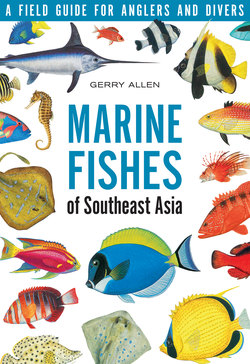Читать книгу Marine Fishes of South-East Asia - Gerry Allen - Страница 18
На сайте Литреса книга снята с продажи.
ОглавлениеDANGEROUS FISHES
The region’s seas are generally safe for normal swimming and wading activities, but there are a number of fishes potentially capable of causing injury. They can be divided into several broad categories including species that bite, sting, or which may cause poisoning if consumed.
Biters - first and foremost in this category are the whaler sharks and their relatives (Plates 1 to 3). In addition there are a number of smaller reef fishes which, although they pose no threat to swimmers, can inflict painful bites if handled carelessly by anglers. For example, barracudas (Plate 69), razorfishes (Plates 78 and 79), and triggerfishes (Plates 100 and 101) are notorious in this respect. As a rule of thumb any fish with large, obvious teeth should be handled with care.
Stingers - virtually any fish which possesses rigid fin spines is capable of inflicting wounds if handled carelessly. Most are non-venomous and can be treated in the same manner as any puncture wound. Surgeonfishes (Plates 93 to 95) are equipped with scalpel-like spines that are either fixed in an erect position or fold into a groove along the base of the tail. Spearfishermen in particular, need to exercise special care when removing these fish from spears as large specimens can sever a finger. The most dangerous category of stingers includes fishes which have venomous spines. The best known of these are stingrays (Plates 4 and 5), catfish (Plate 11), scorpionfishes (Plates 18 to 20), and spinefeet (Plates 92 and 93). For all of these fishes the recommended first-aid procedure is to immerse the injured area in hot water (as hot as bearable), repeating until the pain subsides. Apparently the protein base of the toxin is denatured by heat and relief is sometimes immediate. In cases where the victim is stung by several spines, or if the wound is deep, medical assistance should be obtained. Firefishes, Lionfishes and stonefishes (Plates 18 and 19) have very potent venom in all fin spines. Several deaths have occurred as a result of people who failed to receive immediate first aid after treading on stonefishes.
Poisonous fishes - there are two main types of fishes in this category. The first includes species that have naturally occurring poisons either in their external mucus or in some internal organs, frequently the viscera or gonads. The best known examples are pufferfishes, porcupinefishes, and boxfishes (Plates 103 to 105). Although these fishes are eaten by the Japanese when specially prepared by licensed chefs, they are considered extremely dangerous and specimens from local waters should never be eaten. The symbol P is used in the species accounts to indicate fishes that are naturally poisonous. The second group of poisonous fishes includes species that acquire toxic properties during their life cycle by accumulating a dinoflagellate that lives on dead coral or among algae and is first consumed by herbivorous fishes which are eventually eaten by larger predatory fishes. The toxin known as ciguatera is accumulative and large fishes such as the Red Bass (Pl. 41-12) and Barracuda (Pl. 69-12) are potentially the most dangerous. The symptoms from eating ciguatoxic fish appear from one to 10 hours later and range from mild dizziness, diarrhoea, and a numb sensation of the lips, hands, and fingers, to extreme nausea, coma, and total respiratory failure. The degree of poisoning depends on the amount of fish that is consumed and the concentration of toxin it contains. As a matter of safe practice it would be wise to avoid eating large barracuda, Red Bass, or extraordinary large gropers, all of which have been implicated in ciguatera poisonings in other regions.
